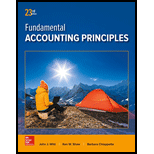
Concept Introduction:
General accounting principle: Generally Accepted Accounting Principle also known as GAAP are a set of principles and procedures in accounting which are widely accepted and commonly used in the preparation of financial statements by business entities. GAAP’s principles and procedures are framed by a policy board i.e. the governing authority whose guidelines must be followed by a business entity at the time of preparing and filing financial statements. GAAPs help in presenting the financial information in a chronological and less- sophisticated manner.
Measurement (cost) principle: Measurement (cost) Principle is a standard accounting guideline, which emphasizes on recording assets as cash or cash equivalents at the time of acquisition/purchase. It is also known as the Historical (Cost) Principle.
Business entity assumption: Business Entity Assumptions are a set of principles of financial accounting, which states that a business is a separate legal and financial entity apart from its owners/stake holders and its employees. The personal financial condition of its owners/stake holders or employees will not have any impact on the financial status and position of the business entity. Business Entity assumption is also called Separate Entity Assumption.
Revenue recognition principle: The principle of revenue recognition states that the revenues are realized or deemed to be realizable when goods are sold or services are provided irrespective of cash receipts i.e. when the cash will be received.
Expense recognition principle: The principle of expense recognition states that expenses are deemed to be recognized in the same time interval as revenue to which it relates. If it is not recognized in the same time interval then it is deemed to be an expense incurred, which would pre-date or follow the period of the receipt of revenue.
Going concern assumption: The principle of Going Concern assumes that a business entity will have perpetual succession or pro-longed existence and unforeseen factors such as winding up or closure will not take place in the near future. With this in mind, an accountant is entitled to defer the recognition of several expenditures to a later period till when a company is assumed to be operating with these assets in an efficient manner.
To write: To understand the general accounting principle, measurement (cost) principle, business entity assumption, revenue recognition principle, expense recognition principle and going concern assumption.
Want to see the full answer?
Check out a sample textbook solution
Chapter 1 Solutions
Fundamental Accounting Principles
- RBI company issues $500,000 face value bonds with a 6% stated interest rate, payable semiannually. The bonds sell for $532,000 (at a premium) and have 10 years until maturity. Using the straight-line method, what is the amount of premium amortization for each semiannual interest payment?arrow_forwardHayden's actual manufacturing overhead for the year was $684,000, and its actual total direct labor was 41,200 hours.arrow_forwardCan you explain the correct methodology to solve this general accounting problem?arrow_forward

 AccountingAccountingISBN:9781337272094Author:WARREN, Carl S., Reeve, James M., Duchac, Jonathan E.Publisher:Cengage Learning,
AccountingAccountingISBN:9781337272094Author:WARREN, Carl S., Reeve, James M., Duchac, Jonathan E.Publisher:Cengage Learning, Accounting Information SystemsAccountingISBN:9781337619202Author:Hall, James A.Publisher:Cengage Learning,
Accounting Information SystemsAccountingISBN:9781337619202Author:Hall, James A.Publisher:Cengage Learning, Horngren's Cost Accounting: A Managerial Emphasis...AccountingISBN:9780134475585Author:Srikant M. Datar, Madhav V. RajanPublisher:PEARSON
Horngren's Cost Accounting: A Managerial Emphasis...AccountingISBN:9780134475585Author:Srikant M. Datar, Madhav V. RajanPublisher:PEARSON Intermediate AccountingAccountingISBN:9781259722660Author:J. David Spiceland, Mark W. Nelson, Wayne M ThomasPublisher:McGraw-Hill Education
Intermediate AccountingAccountingISBN:9781259722660Author:J. David Spiceland, Mark W. Nelson, Wayne M ThomasPublisher:McGraw-Hill Education Financial and Managerial AccountingAccountingISBN:9781259726705Author:John J Wild, Ken W. Shaw, Barbara Chiappetta Fundamental Accounting PrinciplesPublisher:McGraw-Hill Education
Financial and Managerial AccountingAccountingISBN:9781259726705Author:John J Wild, Ken W. Shaw, Barbara Chiappetta Fundamental Accounting PrinciplesPublisher:McGraw-Hill Education





